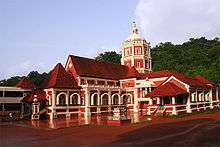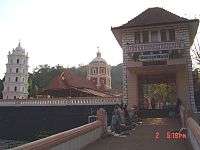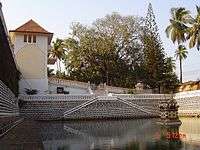Shanta Durga Temple
| Shree ShantaDurga Saunsthan | |
|---|---|
 | |
 Location in Goa | |
| Geography | |
| Coordinates | 15°23′45″N 73°58′04″E / 15.3958323°N 73.9677682°ECoordinates: 15°23′45″N 73°58′04″E / 15.3958323°N 73.9677682°E |
| Country | India |
| State | Goa |
| Locale | North Goa |
| Culture | |
| Sanctum | Shantadurga |
| Major festivals | Magh Shuddha Panchmi (Jatrautsav), Navaratri |
| History | |
| Date built | 16th century |
| Website | http://shreeshantadurga.com/ |
Shri Shantadurga Temple is a Private temple complex belonging to Goud Saraswat Brahmin community(Saraswat Temple). 30 km (19 mi) from Panaji at the foothill of Kavalem village in Ponda Taluka, Goa, India.
H.H.Shrimad Swamiji of ShriKavale Math is Spiritual head Of Shree Shantadurga Saunsthan,Kavale.
Shree Shantadurga is the Kuldevi (family deity) of many Goud Saraswat Brahmin families.
This current temple structure of Shree Shantadurga Devasthan was built during the period from 1713 AD to 1738 AD by Naroram Rege Mantri.On 4 December 2016, the temple completed its 450th year of existence. (Margashirsh Shuddh Panchmi).
Deity
The temple is dedicated to Shantadurga, the goddess who mediates between Vishnu and Shiva. The deity is also called 'Santeri' colloquially. Purana talks of a battle between Shiva and Vishnu The battle was so fierce that the God Brahma prayed to Goddess Parvati to intervene, which she did in the form of Shantadurga. Shantadurga placed Vishnu on her right hand and Shiva on her left hand and settled the fight.
Shantadurga is holding two serpents, one in each hand, representing Vishnu and Shiva.
Some of local legends or beliefs often say that Shantadurga of Keloshi had gone to Sancoale a village in mormugao to kill a demon named Kalantak that was harassing the Brahmins. As a reward, she was given the name of Vijaya. The Vijayadurga shrine was located in Sancoale along with Shantadurga and Lakshmi Narasimha but was later shifted to a place called Kerim in Ponda Taluka during the Portuguese invasions.[1]
Temple
The original temple at Quelossim (Keloshi) in mormugao was destroyed by the Portuguese in 1566. The goddess was shifted to Kavalem and worship was continued there. The site on which the original Temple of Shantadurga stood at Quelossim (Keloshi) is known as "Deoolbhata" and it is in the possession of the Shree Shantadurga Saunsthan Committee,Kavale.
The current temple was constructed during the reign of Maratha ruler Chattrapati Shahu Maharaj of Satara in about 1738 A.D. Naroram Rege Mantri originally from Kochara village in the Vengurla Taluka,(Konkan) was a Mantri (Minister) in Chattrapati Shahu's Court at Satara (Grandson of Shivaji Maharaj)around 1723. He obtained finances to construct the new temple for the goddess from Chh.Shahu Maharaj of Satara. The temple construction started around 1730 . Due to his efforts, the village of Kavalem was bequeathed to the Temple by Shrimant Bajirao-1 Peshwa in 1738.
The temple complex is on the slope of the foothills of a mountain chain, surrounded by lush vegetation. There is a main temple and three smaller temples of other deities which have been built on three sides of the temple. The temple consists of a collection of pyramidal roofs with a dome. The pillars and floors are made of Kashmir stone. The temple has a huge tank, a Deepastambha and agrashalas (guest houses).
Many renovations have been completed over the years to the main temple and the temples of the other deities as well as to the agrashala. The temple has recently banned entry of foreigners into the temple citing objectionable dressing and conduct as the reason. [2]
Architectural Styles
Its pyramidical shape 'shikaras' rising on the roofs of the facade (entrance hall) and the 'Sabhamandap' (the main hall), its roman-arched windows, some of which have the stained-glass window panes of deep red, yellow, blue, green colours, its chandeliers, its gate posts, balustraded flat dome, the maroon-peach-white colour paint of the temple gives the temple a serene beautiful look.
The highlight of the temple is its golden palanquin (palkhi) in which the deity is carried on festive occasions(only 5 Mahapanchmi).
Gallery
 Entrance to the Shri ShantaDurga Saunsthan.
Entrance to the Shri ShantaDurga Saunsthan. The Deepa Stambha of the temple
The Deepa Stambha of the temple Shanta Durga Temple Complex Lake
Shanta Durga Temple Complex Lake Shanta Durga Temple
Shanta Durga Temple.jpg) Shanta Durga Temple - Majestic Deepa Stambha (Lamp Tower)
Shanta Durga Temple - Majestic Deepa Stambha (Lamp Tower) An Elaborate Rangoli in side the Temple during Shatakalash puja.
An Elaborate Rangoli in side the Temple during Shatakalash puja. Shri Shantadurga Temple from front
Shri Shantadurga Temple from front
See also
Notes
- ↑ "Shri Shantadurga Temple, Kavalem". Retrieved 2006-09-21.
- ↑ "Shree Shantadurga Devi , Kavlem , Phonda, Goa - Official Website". Retrieved 2006-09-21.
External links
| Wikimedia Commons has media related to Shanta Durga Temple. |
